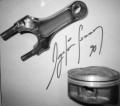Cooling System 02
by , 02-05-2011 at 11:37 PM (2054 Views)
Three hoses under the centre floor section are done.
Moving onto the engine bay.

As seen on other NSX, part of the rubber seal at the Thermostat was already deteriorated and gone missing.
Replaced it with the new spec.
Part of the coolant pipes were already corroded.
Unless you remove the coolant hoses, you wonít be able to check this.
This will be scraped off and treated properly before installing the new hose.
It is important to carry out the 1st coolant replacement at the specified timing and then follow the specified maintenance interval thereafter.
After about 8 - 10 years, please plan to replace all of your coolant hoses especially for those with the aftermarket header and the exhaust.
Any coolant hoses at 15 years old or over, itís like a gamble and good luck with not having the burst hose.
The most common failure would be one of the three hoses under the header tank, one of the two hoses at the Oil cooler or one of the three hoses under the centre floor.
The hoses at the engine bay have been replaced.
The header tank will be installed at the time of Vacuum leak check.
The coolant hoses at the Oil cooler will be installed briefly after the installation of WP in order to perform the leak check before installing the TB.
So, cooling system is pretty much done.
Time to open the valve covers.




 Email Blog Entry
Email Blog Entry

